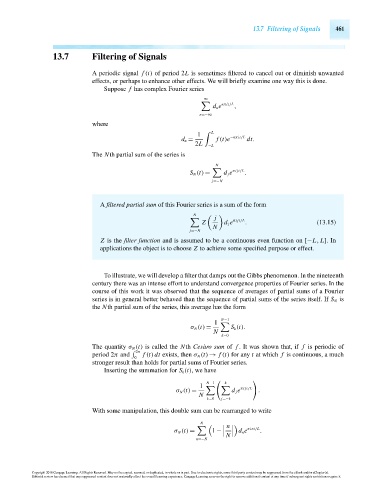Page 481 - Advanced engineering mathematics
P. 481
13.7 Filtering of Signals 461
13.7 Filtering of Signals
A periodic signal f (t) of period 2L is sometimes filtered to cancel out or diminish unwanted
effects, or perhaps to enhance other effects. We will briefly examine one way this is done.
Suppose f has complex Fourier series
∞
nπit/L
d n e ,
n=−∞
where
1 L
d n = f (t)e −nπit/L dt.
2L −L
The Nth partial sum of the series is
N
S N (t) = d j e πijt/L .
j=−N
A filtered partial sum of this Fourier series is a sum of the form
N
j πijt/L
Z d j e . (13.15)
N
j=−N
Z is the filter function and is assumed to be a continuous even function on [−L, L].In
applications the object is to choose Z to achieve some specified purpose or effect.
To illustrate, we will develop a filter that damps out the Gibbs phenomenon. In the nineteenth
century there was an intense effort to understand convergence properties of Fourier series. In the
course of this work it was observed that the sequence of averages of partial sums of a Fourier
series is in general better behaved than the sequence of partial sums of the series itself. If S N is
the Nth partial sum of the series, this average has the form
N−1
1
σ N (t) = S k (t).
N
k=0
The quantity σ N (t) is called the Nth Cesàro sum of f . It was shown that, if f is periodic of
2π
period 2π and f (t)dt exists, then σ N (t) → f (t) for any t at which f is continuous, a much
0
stronger result than holds for partial sums of Fourier series.
Inserting the summation for S k (t),wehave
N−1 k
1
σ N (t) = d j e πijt/L .
N
k=0 j=−k
With some manipulation, this double sum can be rearranged to write
N
σ N (t) = n d n e πint/L .
N
1 −
n=−N
Copyright 2010 Cengage Learning. All Rights Reserved. May not be copied, scanned, or duplicated, in whole or in part. Due to electronic rights, some third party content may be suppressed from the eBook and/or eChapter(s).
Editorial review has deemed that any suppressed content does not materially affect the overall learning experience. Cengage Learning reserves the right to remove additional content at any time if subsequent rights restrictions require it.
October 14, 2010 14:57 THM/NEIL Page-461 27410_13_ch13_p425-464

